Jenova Chen on how Shadow of the Colossus inspired Journey
We dig up a time capsule in the form of a never-before-seen interview conducted a decade ago.

In 2015, Boss Fight Books released a book on Shadow of the Colossus — an analysis of the game’s design and its impact on author (and now game developer) Nick Suttner, assisted by interviews with people who worked on the game and developers who were inspired by it. It’s great; you should check it out.
As is often the case, Suttner wasn’t able to include everything from those interviews in the book, so he set up a website to host extended transcripts. He wasn’t able to get to all of them, though, so when I mentioned I was doing an oral history for the game’s 20th anniversary, he offered to send over a couple of bonus recordings for us to transcribe and host here.
Below, you’ll find the first of those two, as Suttner talks to Thatgamecompany creative director Jenova Chen about his breakout adventure game Journey and how it was influenced by Shadow of the Colossus. As you might expect from an interview conducted a decade ago, some of the references are a bit dated — I’d nearly forgotten about Farmville — but a lot of the discussion feels as relevant today as it did back then.
